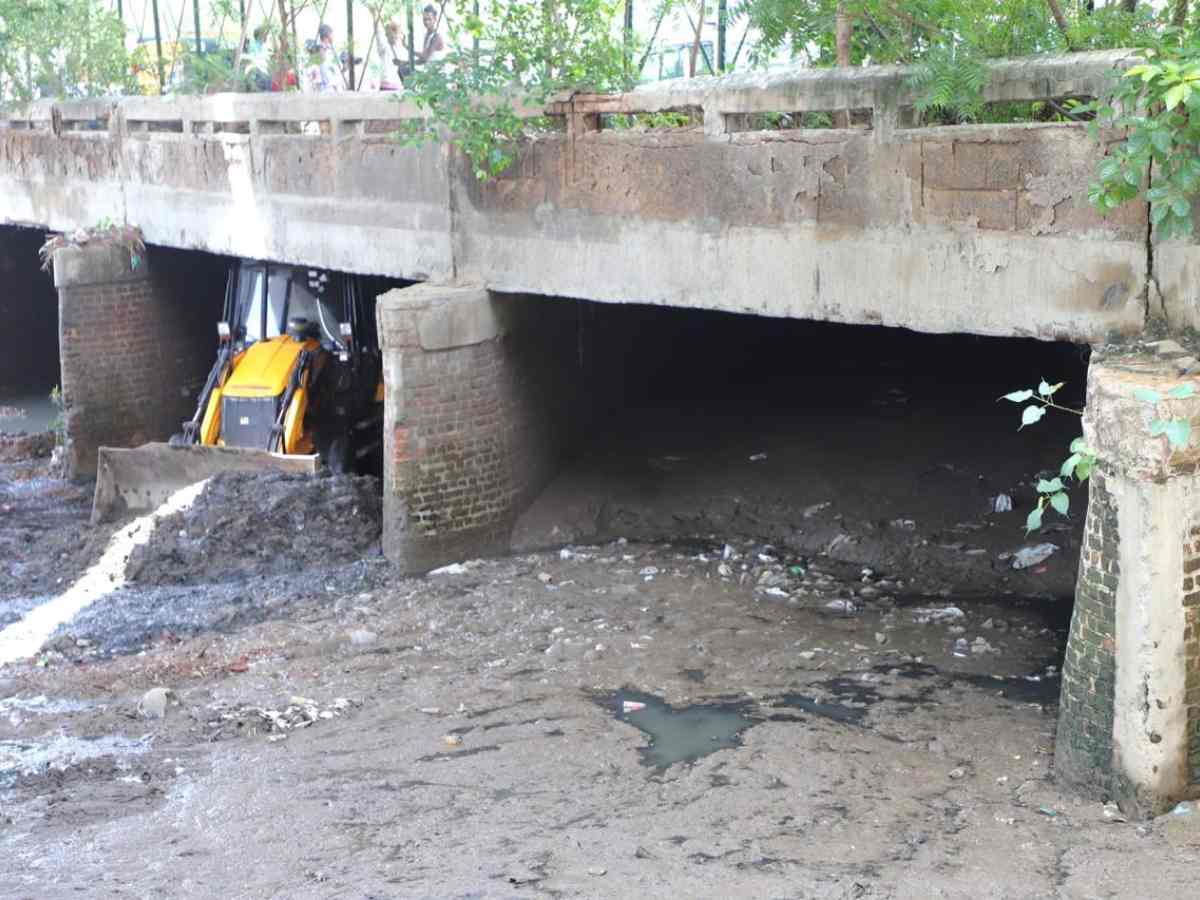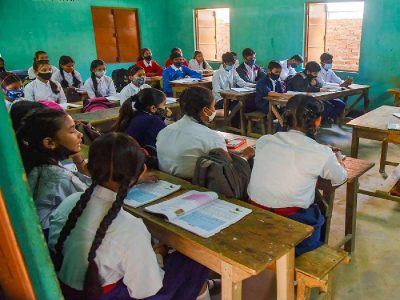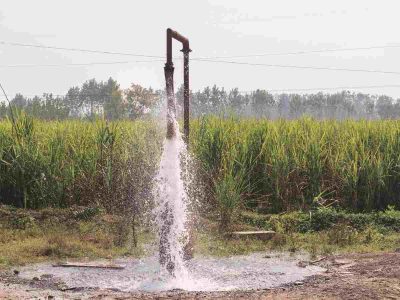Delhi: A spate of torrential rainfall over the past weeks in the national capital has left roads inundated, leading to long traffic jams besides claiming several innocent lives.
After every heavy downpour in Delhi, multiple agencies responsible for managing the drains in the Capital pass the buck on each other for the problems in the desilting of major drains following which waterlogging takes place on the streets.
Even 20-minute long intervals of rain have also been able to push the entire Capital to a standstill owing to the fact that the drains responsible for carrying the rainwater to the Yamuna river are semi-clogged or fully clogged due to the lack of attention of the civic agencies.
Patriot visited some of the major drains in the national capital to check the reason behind severe waterlogging in the city which has claimed multiple lives and brought the city to its knees during monsoon.
During the visit, it was observed that the drains have not been desilted by the civic authorities despite the claims. People residing near the drains depicted the horrific tale of the situation of localities during the heavy downpour.
Also read: Independence Day: The 17th century monument and symbol of a free India
Barapullah Drain
The historic Barapullah Drain is reeling under severe apathy, with only five out of its 12 bays actually functioning with rest being clogged to the brim with dirt, debris and garbage thrown from the adjoining slums.
In the 19th century, the drain was considered a tributary of the Yamuna but now it has become a shadow of its former self. Presently, the drain is home to a pile of garbage that blocks the bays, not letting any of the sewage water to get filtered out and fall into the river.
However, this has also caused enormous amount of flooding in the surrounding areas such as Nizamuddin, Lodhi Road, Jungpura, among others.
Rafique Saeed, a resident of the Nizamuddin slums, told Patriot, “Whenever there is a tiny bit of rain, the drain cannot handle it because there has been no desilting in this area and we are left to fend for ourselves. Thus, a localised flood affects us every time. It enters our homes, our shops, all of the eateries, and this also becomes a health hazard due to multiple live wires lying here and there.”
Kushak and Sunheri Drain
The Sunehri Drain had three out of its six bays clogged with garbage and silt which resulted in rather slow movement of the sewage water to the Yamuna. Similarly, Kushak Drain was also clogged as the local market’s garbage is usually disposed of there.
Without any checks and balances, years of compounded trash got collected at the bay, resulting in a clogged and choked drain with no way to reach the river. Rekha Jaiswal, a resident of Bharti Nagar, said that the Kushak Drain had run its course and was only getting by now.
“It cannot withstand the amount of sewage that is produced in Delhi now. It was built according to a particular amount of population but it was never developed further. Usually, it takes only a month for the drain to get clogged and then start overflowing onto the streets,” she added.
Shahdara Drain
The drain linking Ghazipur Drain to Shahdara Drain has seen much better days. After a few days under the scanner, the MCD had ordered an extensive desilting of the area. However, even after the exercise, there are tonnes of garbage.
Mini islands of trash have formed in the middle of the stream. Heaps of garbage have formed on the sides of the drain where a herd of cows have made their grazing spot. Without a hint of grass at the spot, their course of meal mostly comprises an appetiser of plastic wrappers.
Apart from the primary drain that is clogged, the smaller tertiary drains leading to it have it worse, becoming the primary reason for waterlogging in the area. Choked with garbage ranging from plastic wrappers and mobile phone boxes, the drains have also become host to animal waste from the slaughterhouse with maggot-infested bodies of livestock.
This has, inadvertently, led to both the drain getting clogged and the surface level water not finding any way into the primary drain.
According to Roshan Lal Sharma, 65, the MCD had been to the area for two days and placed the sludge on the sides of the drain.
“It is only logical to assume that the amount of sludge collected by the JCBs which were kept on the sides have slid down into the drain again after the rain. They had last arrived here after the death of the woman and her child, but their activity soon died down,” he said.
Additionally, at the Shahdara outfall drain which links Shahdara Drain with the Mayur Vihar Phase 3 Drain, one of the three bays has been excessively clogged with debris and silt.
The site is also home to a Delhi Jal Board (DJB) filtration unit which has become defunct owing to the construction of the Rapid Rail Transit System (RRTS) which is slated to connect the national capital to Meerut in Uttar Pradesh.
“Anybody can fall inside the drain since there is no parapet or railing guarding it. Authorities have said that they can only build a cement railing after the RRTS project is done with. Just because the drain is low lying, there have been no instance of flooding in the area but the passage of sew age water is relatively slow with one of them being blocked in totality,” said an official from the DJB, on condition of anonymity.
Also read: Delhi: Proposed education hub in Narela moves at snail’s pace
Noida Barrage and Ashok Nagar Drain
The Noida barrage connecting Delhi’s sewage water to Yamuna River has also been filled up with mini islands of sludge, while Ashok Nagar’s drain remains dormant with silt lining all four of its bays.
A caretaker of the drainage system said that it will be cleared the moment the RRTS is underway. “The cleaning exercise cannot start before the metro begins,” he said.
Tehkhand Drain
The drain lining South East’s Tehkhand village has seen better days, as the slender stream trickles through with little space for the water to flow. Starting from Tughlakabad, the drain meanders through a small shanty to finally pass through the village’s market where it becomes host to a plethora of waste.
The drain’s sludge contains everything from the remains of the day’s produce, including animal remains and plastic wrappers.
This has effectively led to one of the two entry points of the drain to get clogged with waste. However, shopkeepers are of the opinion that the drain flows through as normal.
“For the past 20 years, the drain has been the same and no problem has arisen out of it. We keep throwing our waste into the stream since we do not have any other option. Authorities do not come here either,” said Pradeep Yadav, a butcher at the market.
Unfortunately, residents of the adjoining village are not of the same opinion. As the drains get clogged, so do their homes the moment it rains more than usual.
Iqbal Ali, a resident, said, “Everyone here who stays beside the drain is afraid of even a tiny bit more rainfall than usual because of the simple reason that it starts over flowing. The moment it starts over flowing, water seeps in through the cracks on the ground or it overflows the roads. Since the drain cannot take any more water, our houses get flooded, specifically, the lower floors.”
Recounting the sad events
According to the Delhi Police, there have been 18 deaths across the national capital in the past two months. These deaths were caused mostly due to electrocution or drowning, with almost six victims being children aged between three and 10. Out of the total number, 11 had died due to drowning while seven died due to electrocution.
The most recent incident happened on August 11, when a seven year-old child, Tarun, drowned inside a pool of water that had formed due to the rains at a Delhi Development Authority (DDA) owned park at Rohini’s Sector-20.
Another incident took place on August 9 when two boys, identified as 15-year-old Uday and 17-year-old Mayank, drowned to death. Allegedly, they were taking a swim inside a pool formed due to the rains in a Delhi Development Authority (DDA) owned land near Rani Khera Bus Depot at Madanpur Extension.
Similarly, it was the death of a woman, Tanuja, and her three-year old child which raised concerns about waterlogging. She had fallen into an uncovered waterlogged drain in east Delhi’s Ghazipur, on July 31.
On July 27, Old Rajinder Nagar’s waterlogging incident also resulted in the death of three IAS aspirants — Tania Soni, 25, Shreya Yadav, 25, and Navin Delvin, 28. They drowned to death inside one of the basement libraries.
Multiple areas in the national capital, including East Delhi, South East Delhi and Central Delhi, bore the brunt of enormous traffic con gestion owing to waterlogging.
However, it is not just drowning but also electrocution which has caused a rise in the number of deaths. On July 24, a 26-year-old IAS aspirant was electrocuted to death at Patel Nagar. According to police officials, the aspirant, Nilesh Rai, had allegedly slipped from the pavement and used the metal gate at the spot for support where he was electrocuted to death.
Their deaths had caused enormous uproar and had led to both the Municipal Corporation of Delhi (MCD) and the Delhi Development Authority (DDA) throwing allegations at each other. The MCD alleged that the DDA was the land-owning authority and inadvertently, they had been entrusted with clearing of the drains. However, the DDA refuted saying that the extent which had not been covered fell under the ambit of the MCD after they had transferred the drain under the latter’s management.
In July, the MCD had said that they had desilted 14 of the drains, including Vijay Ghat Drain, ISBT Drain, Kailash Nagar Drain (on the eastern bank of Yamuna), Shastri Park Drain (on the eastern bank of Yamuna), Drain No. 14, Tehkhand Drain, Sen Nursing Home Drain (Drain No. 12), Delhi Gate Drain and Abul Fazal Drain.
Major Drains in Delhi
Delhi has 18 major drains which fall into the Yamuna River, including Magazine Road Drain, Sweeper Colony Drain, Khyber Pass Drain, Metcalf House Drain, Tonga Stand Drain, Moat Drain, Civil-Military Drain, Delhi Gate Drain, Drain No. 14, Tughlakabad Drain, Kalkaji Drain, Tehkhand Drain, Sen Nursing Home Drain (Drain No. 12), Shahdara Drain, Najafgarh Drain, Mori Gate Drain, Barapullah Drain, and the Maharani Bagh Drain.





